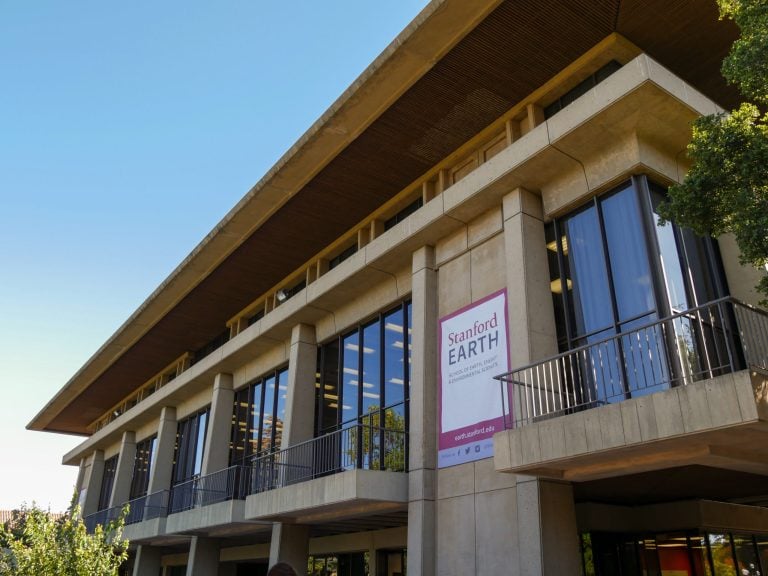Stanford is now running on 100% renewable electricity, the University announced in late March.
The milestone comes after Stanford’s second solar station — Stanford Solar Generating Station #2 (SSGS2), located near Lemoore — went online in the middle of the month.
“This is really core to Stanford’s long-term commitment to sustainability,” said Lincoln Bleveans, Stanford’s executive director of sustainability and energy management. “This is a multi-step, multi-year commitment to an integrated solution that spans years and also spans administrations at the University. And it’s just an incredible example of Stanford walking the walk in its long-term commitment to sustainability and really focusing on real-world solutions.”
Stanford’s first solar plant, located in Rosamond, came online in 2016 and brought Stanford to about 68% renewable electricity, according to Ron Gawer, the director of energy operations for Stanford’s Land, Buildings & Real Estate division. Together, the two solar plants are producing 120% of Stanford’s annual electricity consumption, Gawer said. He called the transition a “beautiful milestone.”
“To say that you’re getting your electricity 100% renewable — to me, it’s just remarkable,” Gawer said.
Despite this latest milestone, Stanford hasn’t reached 100% renewable energy quite yet. Achieving this metric would require all campus activities, including car use, kitchens and heat, to run off renewable sources. Gawer said that Stanford is currently operating at about 70% renewable from a total energy standpoint. While 100% of Stanford’s electricity and chilled water can be described as renewable, about 15% of the University’s winter heating still comes from natural gas, according to Gawer.
Stanford first committed to long-term renewable electricity use with its launch of the Energy and Climate Action Plan in 2009. Two years later, the Board of Trustees gave concept approval to the Stanford Energy System Innovations (SESI) project, which included the introduction of the two solar plants, as well as other efforts to transition Stanford away from fossil fuels.
The two solar plants, in conjunction with other SESI initiatives, will reduce Stanford’s greenhouse gas emissions by 78% from 2011 peak levels. SESI will also contribute to an 18% reduction in the University’s potable water use. These statistics, according to Gawer, take into account Stanford and its “research and support facilities,” such as the Redwood City campus and Hopkins Marine Station. They do not include buildings operated by Stanford Health Care.
So what does “100% renewable electricity” mean in practice?
Gawer describes California’s grid as a swimming pool. Stanford’s solar generating stations can be thought of as “putting water into the pool,” Gawer said. Stanford is one of many entities in California that takes water out of that pool to power its operations.
This means that the electricity used on campus — whether by a computer charger or a TV — is not necessarily coming directly from Stanford’s two solar plants.
“The electricity that we consume — the electron going into our computers here on campus — it’s highly unlikely it’s the same electron that was generated at the solar plant,” Gawer explained. “It’s not a fixed wire, like an extension cord. And so what we’re doing is we’re putting electricity into the grid, and we’re consuming it here.”
SSGS2 is Stanford’s portion of Slate, a larger solar energy project that was developed beginning in 2015 by Recurrent Energy, a subsidiary of Canadian Solar. The plant was purchased by Goldman Sachs Renewable Power in January 2021. Stanford is one buyer of the energy generated by the facility, which sits on about 420 acres.
While Stanford explored other renewable energy options, the University settled on solar as the most economically and technically viable option, according to Gawer.
Representatives from Students for a Sustainable Stanford (SSS) called the transition “a wonderful step on the road to becoming a more sustainable university,” adding that they hope that Stanford “will continue to work toward net-zero emissions and possibly even accelerate its timeline for doing so.”
While SSS was not involved in the transition process, the group is continuing to work toward helping Stanford eliminate Scope 3 emissions, which include commuting and air travel, among other activities. Stanford hopes to eliminate Scope 3 emissions by 2050.
But while Stanford has committed itself to transitioning away from fossil fuels on campus, debates over divestment persist. Stanford’s endowment remains indirectly invested in fossil fuels, though the University has no direct holdings in the 100 major fossil fuel companies, as defined by the group Fossil Free Stanford (FFS).
Representatives from FFS could not be reached for comment on Stanford’s electricity milestone.
For Bleavans, the transition epitomizes why he came to Stanford after a nearly 30-year career in the global energy industry.
“We have really just gotten started,” Bleavans said, adding that he has been inspired by “the incredible desire and commitment of the University to position itself as a leader — not just to make things great for Stanford, but also to be that exemplar for the rest of the world.”
“This is a perfect example of why I’m here and why we’re all so excited to be part of this journey,” he said.
